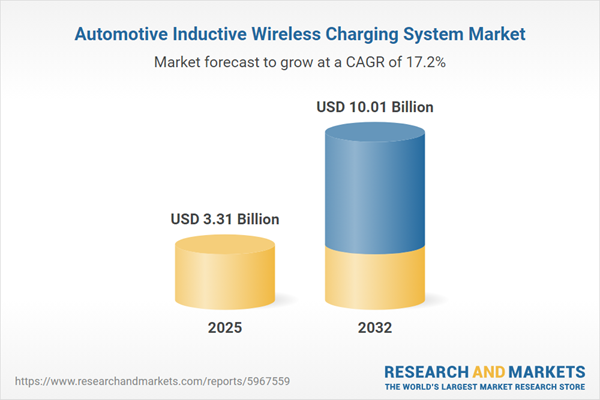Speak directly to the analyst to clarify any post sales queries you may have.
The automotive inductive wireless charging system market is transforming electric vehicle charging, driving scalable growth and innovation across global mobility. As leading stakeholders respond to rapid shifts in technology, regulation, and user demand, this segment is redefining the future of automotive electrification.
Market Snapshot: Automotive Inductive Wireless Charging System Market Size and Growth
The Automotive Inductive Wireless Charging System Market expanded from USD 2.81 billion in 2024 to USD 3.31 billion in 2025, advancing at a compound annual growth rate (CAGR) of 17.16% and projected to reach USD 10.01 billion by 2032. This robust trajectory reflects growing demand for seamless, cable-free EV charging solutions in response to electrification, sustainability targets, and next-generation grid integration. Key industry momentum is supported by advances in magnetic resonance coupling and increased investment in scalable infrastructure deployments. Stakeholders include automotive OEMs, component suppliers, energy utilities, and public sector agencies.
Scope & Segmentation
This report delivers a comprehensive analysis of the automotive inductive wireless charging system market, offering detailed segmentation and geographic breakdowns to inform strategic decisions:
- Vehicle Types: Commercial vehicles (bus, truck), passenger vehicles (electric cars, hybrid cars)
- Charging Modes: Dynamic (in-motion, quasi-dynamic), static
- Charging Power: Up to 3.7 kW, 3.7 to 11 kW, above 11 kW
- End Users: Aftermarket (fleet service providers, individual customers), Original Equipment Manufacturer
- Geographic Regions:
- Americas (United States, Canada, Mexico, Brazil, Argentina, Chile, Colombia, Peru)
- Europe, Middle East & Africa (United Kingdom, Germany, France, Russia, Italy, Spain, Netherlands, Sweden, Poland, Switzerland, United Arab Emirates, Saudi Arabia, Qatar, Turkey, Israel, South Africa, Nigeria, Egypt, Kenya)
- Asia-Pacific (China, India, Japan, Australia, South Korea, Indonesia, Thailand, Malaysia, Singapore, Taiwan)
- Leading Providers: WiTricity Corporation, Qualcomm Incorporated, Evatran Group, Momentum Dynamics, Aptiv PLC, Robert Bosch GmbH, Siemens AG, Samsung Electronics, Panasonic Corporation, Hyundai Mobis
Key Takeaways
- Automotive inductive wireless charging streamlines EV charging by enabling contactless energy transfer, reducing manual intervention and supporting next-generation mobility solutions.
- Advancements in resonant coupling technology and power electronics are increasing system efficiency and vehicle interoperability, serving multi-brand and multi-segment deployment needs.
- Emerging global standards and cross-industry alliances facilitate unified ecosystem development, accelerating market readiness for large-scale infrastructure rollouts and dynamic charging corridors.
- Shifting regulatory frameworks and government-sponsored incentive schemes support commercialization and pilot projects in key urban, transit, and fleet applications worldwide.
- Consumer demand for frictionless, reliable charging is encouraging automakers and aftermarket providers to integrate wireless solutions at both OEM and retrofit levels, broadening adoption potential.
Tariff Impact and Supply Chain Adaptations
Recent U.S. tariff changes on electronic components in 2025 are impacting procurement strategies and manufacturing costs across the automotive inductive wireless charging market. Stakeholders are adopting nearshoring, fostering new supplier relationships, and assembling charging hardware regionally to mitigate increased duties. These adaptations are enhancing supply chain resilience and ensure continued competitiveness amid evolving trade policies.
Methodology & Data Sources
This report employs a multi-layered research methodology, integrating public-domain intelligence such as regulatory filings, patent databases, and technical whitepapers, with qualitative interviews involving senior automotive, supplier, and infrastructure executives. Quantitative data is validated through confidential industry surveys and supply chain mapping. Expert panels and technical advisors review findings for accuracy and actionable insight.
Why This Report Matters
- Enables senior leaders to benchmark strategies, investment plans, and technology adoption against current and emerging trends in automotive inductive wireless charging systems.
- Delivers actionable insights on risk mitigation, manufacturing best practices, and regulatory navigation for well-informed decision-making in a volatile global landscape.
- Provides a framework for identifying partnership and innovation opportunities aligned with evolving consumer, technology, and regulatory requirements across key regions.
Conclusion
The automotive inductive wireless charging system market is evolving rapidly, driven by innovation, policy support, and user expectations for seamless experiences. Senior leaders leveraging this analysis will be poised to drive adoption and create sustainable value in the future of mobility.
Additional Product Information:
- Purchase of this report includes 1 year online access with quarterly updates.
- This report can be updated on request. Please contact our Customer Experience team using the Ask a Question widget on our website.
Table of Contents
3. Executive Summary
4. Market Overview
7. Cumulative Impact of Artificial Intelligence 2025
Companies Mentioned
The companies profiled in this Automotive Inductive Wireless Charging System market report include:- WiTricity Corporation
- Qualcomm Incorporated
- Evatran Group, Inc.
- Momentum Dynamics, Inc.
- Aptiv PLC
- Robert Bosch GmbH
- Siemens Aktiengesellschaft
- Samsung Electronics Co., Ltd.
- Panasonic Corporation
- Hyundai Mobis Co., Ltd.
Table Information
| Report Attribute | Details |
|---|---|
| No. of Pages | 186 |
| Published | October 2025 |
| Forecast Period | 2025 - 2032 |
| Estimated Market Value ( USD | $ 3.31 Billion |
| Forecasted Market Value ( USD | $ 10.01 Billion |
| Compound Annual Growth Rate | 17.1% |
| Regions Covered | Global |
| No. of Companies Mentioned | 11 |







